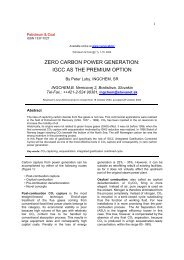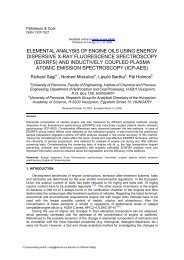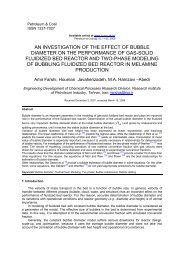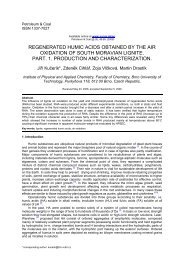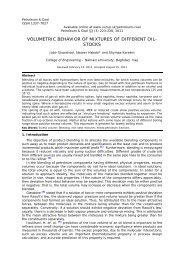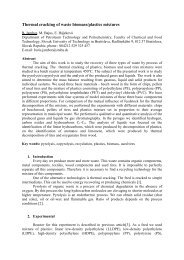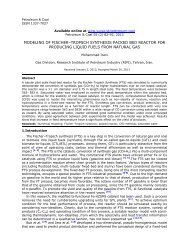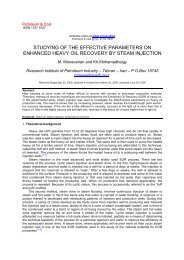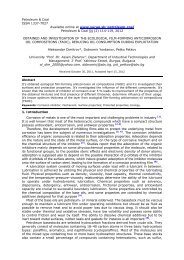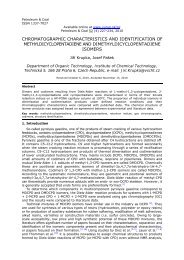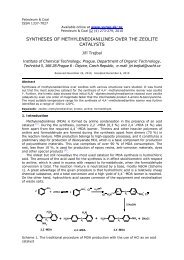permeability estimation and hydraulic zone pore structures
permeability estimation and hydraulic zone pore structures
permeability estimation and hydraulic zone pore structures
You also want an ePaper? Increase the reach of your titles
YUMPU automatically turns print PDFs into web optimized ePapers that Google loves.
Step 1: Perform quality control on <strong>permeability</strong> <strong>and</strong> porosity data to generate a st<strong>and</strong>ardporosity - <strong>permeability</strong> plot mainly to recognize bad core data. Besides, to identify anyfractured core plugs that exhibit high <strong>permeability</strong> with low porosity. Observe any obviousrock type groupings that are easily identified to give some indications of the number ofpotential <strong>hydraulic</strong> <strong>zone</strong>s.Step 2: Use Eq. (6) to group <strong>permeability</strong> <strong>and</strong> porosity data into <strong>hydraulic</strong> <strong>zone</strong>s <strong>and</strong> choose<strong>hydraulic</strong> <strong>zone</strong>s that represent macro <strong>pore</strong>s (<strong>hydraulic</strong> <strong>zone</strong> 1); meso-<strong>pore</strong>s (<strong>hydraulic</strong> <strong>zone</strong>2); <strong>and</strong> micro <strong>pore</strong>s (<strong>hydraulic</strong> <strong>zone</strong> 3).Step 3: Display the log responses with log estimated <strong>hydraulic</strong> <strong>zone</strong>s to as-certain that logsare responding to differences in <strong>pore</strong> type. Compare the log displayed <strong>and</strong> proportion of each<strong>hydraulic</strong> <strong>zone</strong> with core descriptions. The log representation of <strong>hydraulic</strong> <strong>zone</strong>s should matchgeologic descriptions from “core when core is available. The <strong>hydraulic</strong> <strong>zone</strong> log shows the<strong>pore</strong> type distribution found in the reservoir volume sampled by well logs. The relativeproportions of micro, meso <strong>and</strong> macro <strong>pore</strong>s can be used to determine which relative <strong>permeability</strong><strong>and</strong> capillary pressure curves best represent each reservoir layer.Step 4: Constrict a predictive <strong>permeability</strong> database with unique log responses for eachcore plug <strong>permeability</strong>. The database will have three or four log values for each depth level<strong>and</strong> one laboratory measured <strong>permeability</strong>. The goal is to find unique log responses for a 20liter volume which can be linked to a 20 milliliter core plug for which <strong>permeability</strong> is reported.The entire range of <strong>permeability</strong> in the reservoir must be included in this database.Step 5: Predict <strong>permeability</strong> from log values by comparing to log values stored in the database.There should be a match between log <strong>and</strong> core <strong>permeability</strong> at all <strong>permeability</strong> ranges.When there is a match between all log values at a particular depth level <strong>and</strong> those found inthe database, <strong>permeability</strong> is estimated.3. Case StudiesPermeability <strong>estimation</strong> data presented for s<strong>and</strong>stone reservoirs was used for the study.The <strong>permeability</strong> <strong>estimation</strong>s by Kriging <strong>and</strong> Timur’s porosity - <strong>permeability</strong> transform (Eq.2)are compared. Additionally, foot by foot <strong>permeability</strong> estimates from well logs are comparedto layer average <strong>permeability</strong> from core.4. Results <strong>and</strong> DiscussionsY. B. Adeboye, C. E. Ubani, K. K. Farayola/Petroleum & Coal 54(1) 52-58, 2012 55Results are presented for a single s<strong>and</strong>stone reservoir to allow for comparability betweenvarious <strong>permeability</strong> <strong>estimation</strong> techniques. Many different s<strong>and</strong>stone reservoirs have beenstudied with this method <strong>and</strong> results are consistent with the observation reported in thisstudy. Figure 1 is from a s<strong>and</strong>stone reservoir with both Aeolian <strong>and</strong> fluvial faces. More thaneight different faces were identified. The log <strong>permeability</strong> versus porosity plot shows anapparent strong dependency of <strong>permeability</strong> on porosity with a correlation coefficient r2equals 0.91.Figure 1 Porosity –Permeability PlotFigure 2 Hydraulic Zone Plot



